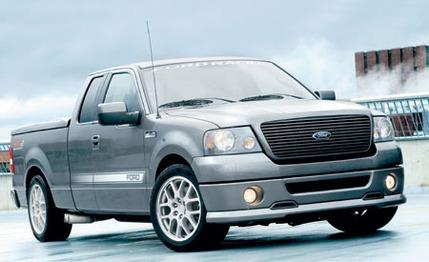 Specialty File
Specialty File
If you're still lamenting Ford's decision in 2004 to stop building the supercharged Lightning pickup, here is at least partial relief. The 2007 F-150 FX2 is a rolling demonstrator on how pickup power freaks can create their own speedy trucks with parts from the Ford Racing catalog (www.fordracingparts.com).
The Lightning was a hot-rod version of the Ford F-150 pickup that first appeared in 1993 with a 240-hp V-8 and a $20,000 price tag. Production only went until 1995, but a second-generation version bowed in 1999 with a supercharged 360-hp V-8 that eventually produced 380 horsepower before it was put to rest in 2004.
A go-fast pickup makes little sense because, if you wanted to go fast, you'd naturally start with a lighter vehicle. But Ford wisely retained practical features in the F-150's conversion to a Lightning — the 2004 model could tow 5000 pounds and carry 800 pounds of stuff. Try that in a Mustang.
Almost everyone expected the Lightning to continue when the current-generation F-150 hit showrooms in 2004. It's hard to say exactly why that didn't happen, but part of the blame lies with the Ford GT supercar because it soaked up much of the engineering resources of Ford's Special Vehicle Team, the division that engineered both Lightnings. Also, even in its best year, the Lightning accounted for less than one percent of F-150 sales, and that probably wasn't significant enough to justify the cost of building it. We're not even sure if the Lightning will make a return when the '09 F-150 debuts sometime next year.
Those who still want a new Lightning will have to build it or hire someone to do it. Start with any F-150 that has the 300-hp, 5.4-liter engine, which in this case is a two-wheel-drive FX2 Sport extended cab (base price: $30,390), then add the supercharger kit ($5530, or $6079 for the polished one on our test truck), a side-exhaust system ($589), a heavy-duty radiator ($660), 20-inch wheels ($1360), a suspension-lowering kit ($688), a 4.10:1 rear-end gear with limited-slip differential ($690), and finally, a big-brake system that has not yet been priced, but figure about two grand. Installing these parts runs about $1000, and there's bad news: Even if you hire a dealer to install the blower, it voids the factory warranty.
For about $44,000, this not-a-real-Lightning has a claimed 450 horses, runs the quarter-mile in 14.4 seconds at 94 mph, and sprints to 60 mph in 5.7 seconds. Its engine feels a lot like the one in the old Lightning — quick, with satisfyingly strong throttle response and a good dose of supercharger whine. But it differs in one significant way — it's slower.
The old Lightning hit 60 mph in 5.2 seconds and the quarter in 13.8 seconds at 104 mph, thanks to a lighter body. Lightnings were only ever available in the lightest and smallest pickup body offered: the regular cab. This project truck was built on a SuperCab, which has a set of rear-hinged doors and a back seat fit for humans. Those are handy, for sure, but the 4702-pound Lightning was a whopping 826 pounds lighter.
In addition to the extra weight, this project truck (first shown at SEMA last fall) suffered when compared with the Lightning due to a wheelbase that is 12.7 inches longer. Whereas the Lightning would feel almost agile — at least for brief spurts — there was no such sensation with the project truck; the driver was constantly aware of its size and bulk. It did, however, manage to post a respectable skidpad number (0.81 g) and braking figure (177 feet), but unless it's going straight ahead at full throttle, there's not much sport here.
The real story is that buyers can devise their own high-performance versions of the F-150 with features that were never available on the Lightning — for example, four forward-hinged doors or four-wheel drive. The best option for speed-minded folks like us is to begin with a regular-cab XLT with the 5.4-liter engine. That truck costs $26,945, and if you added just the supercharger and rear-end parts (roughly $7000 including labor), the result would be a $34,000 truck that's as close in spirit and stamina to the Lightning as we're going to get for the foreseeable future.